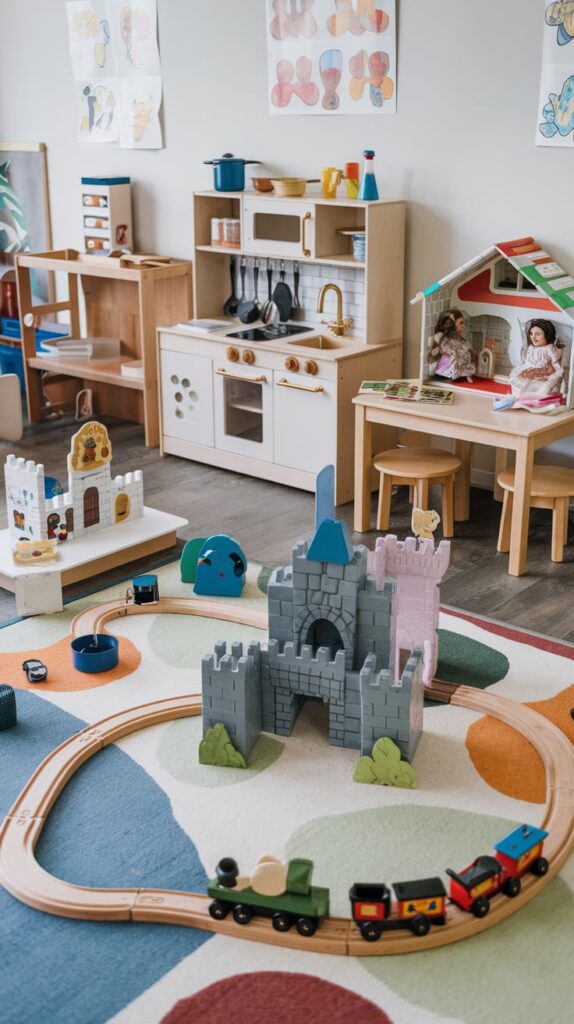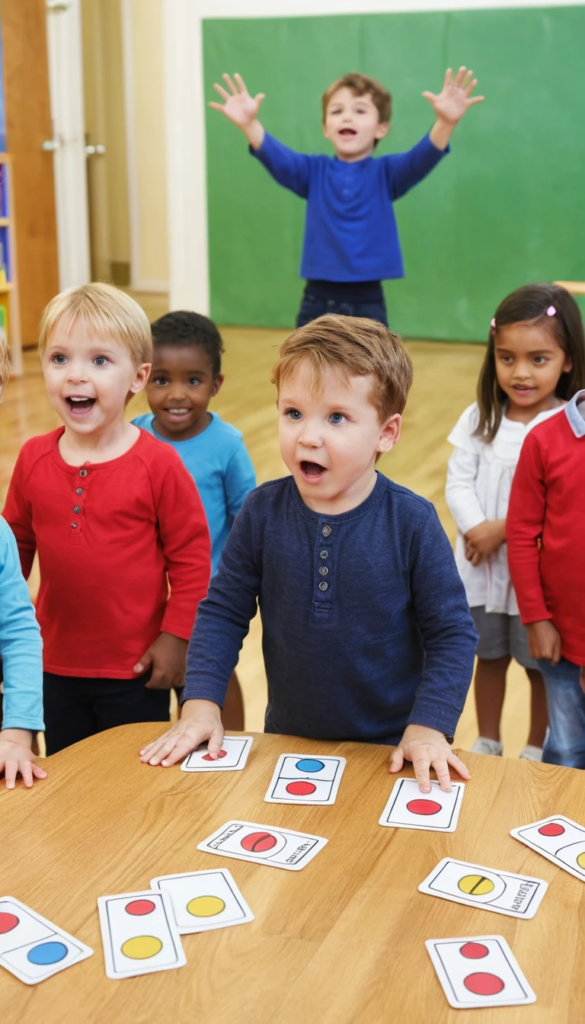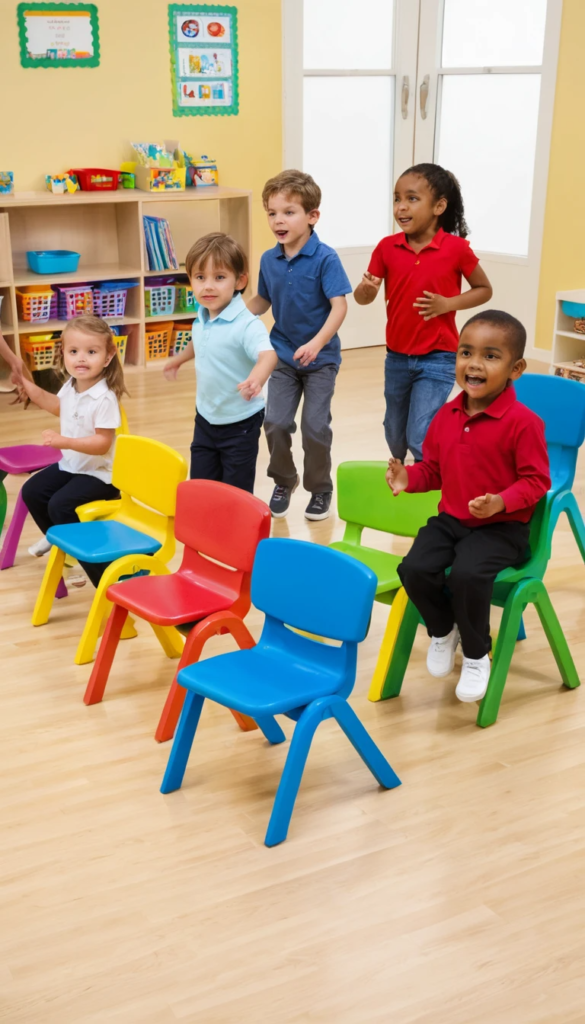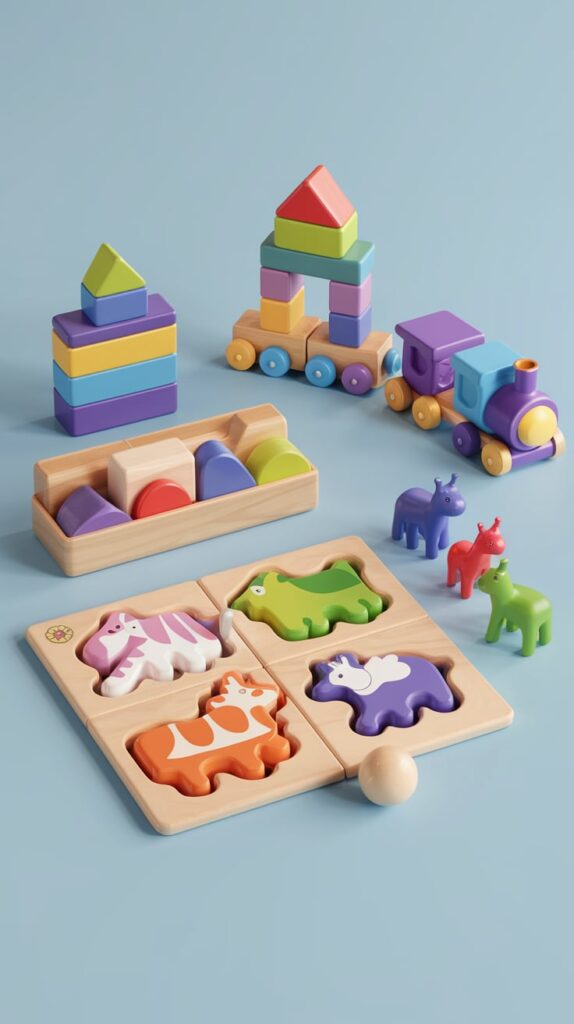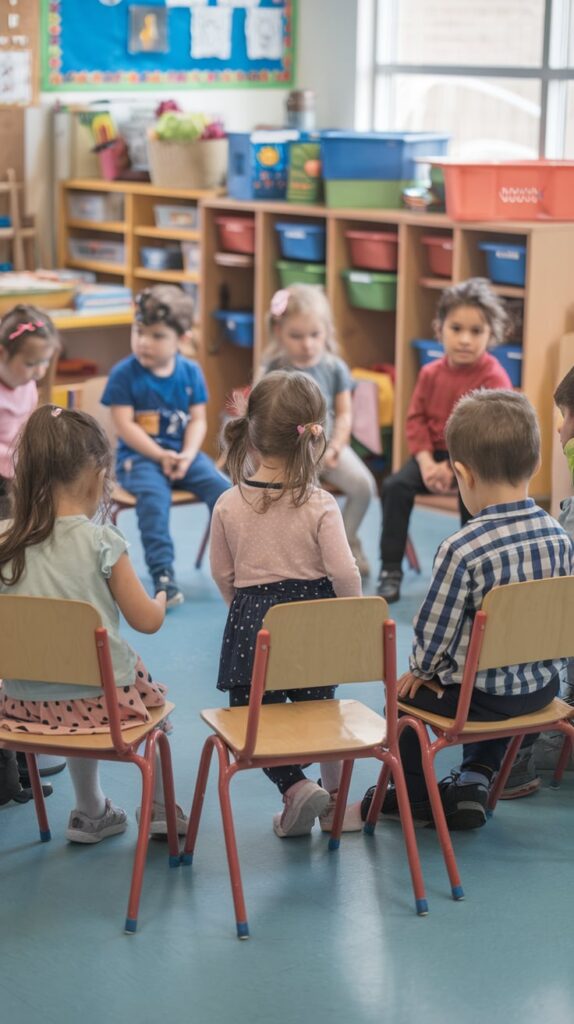Preschool game ideas are designed to engage young children in fun, educational activities that help develop their cognitive, motor, and social skills. These games focus on simplicity, creativity, and interaction, making them ideal for preschoolers’ short attention spans. Classic games like Simon Says and Duck, Duck, Goose encourage listening skills and physical coordination, while Musical Chairs introduces kids to the concept of friendly competition. Color Hunts and Shape Sorting games help with color and shape recognition, enhancing early learning.
Freeze Dance is perfect for releasing energy and improving body control as children dance to music and freeze when it stops. Arts and crafts-based activities like Play-Dough Creations and Painting Stations nurture creativity and fine motor skills, allowing little ones to express themselves. Simple team games like Parachute Play promote cooperation as kids work together to bounce balls or make waves with a large parachute. Additionally, story-based games like Animal Charades encourage imagination and build confidence in expressing ideas. These Preschool Game Ideas not only entertain preschoolers but also provide essential developmental benefits in a fun and engaging way.
Preschool Game Ideas
Here’s a list of 60+ Preschool Game Ideas that are fun, educational, and designed to engage young children in developing various skills like motor coordination, creativity, social interaction, and learning basic concepts.
100+ Preschool Game Ideas List
- Simon Says
- Duck, Duck, Goose
- Musical Chairs
- Freeze Dance
- Hide and Seek
- Color Hunt
- Shape Sorting
- Animal Charades
- Building Blocks Challenge
- Treasure Hunt
- Balloon Bounce
- Parachute Play
- Ring Toss
- Follow the Leader
- Indoor Bowling
- Obstacle Course
- Memory Match Game
- I Spy
- Pin the Tail on the Donkey
- Puzzle Play
- Stacking Cups
- Musical Statues
- Animal Sounds Game
- Farm Animal Hop
- Sorting Colors
- Jumping Jacks
- Playdough Sculpting
- Bean Bag Toss
- Fish Pond Game
- Hopscotch
- Bubbles Pop
- Storytime with Puppets
- DIY Sensory Bin
- Painting Party
- Shape Walk
- Obstacle Maze
- Coloring Pages
- Play Kitchen Time
- What’s Missing?
- Hot Potato
- Make a Mask
- Ball Toss Relay
- Nature Scavenger Hunt
- Animal Walks (e.g., hop like a frog)
- Balance Beam Walk
- Fruit and Vegetable Sorting
- Fishing Game
- Treasure Map Adventure
- Paper Airplane Race
- Musical Cushions
- Indoor Gardening
- Dance Party
- Pin the Pumpkin on the Patch
- Counting with Blocks
- Alphabet Hunt
- Dinosaur Dig (sensory activity)
- Rainbow Walk (with colored tape)
- Make a Sensory Bottle
- Puddle Jumping (indoor or outdoor)
- Follow the Footprints
- Sand Play (or sandbox play)
- Freeze Tag
- Puzzle Hunt
- Matching Socks Game
- Animal Parade
- Craft Stick Building
- Playdough Printing
- Count the Stars (star-shaped items)
- Matching Colors with Clothes
- Lacing Shapes
- Counting Stones
- Finger Painting
- Hop the Shape Path
- Musical Instruments Play
- Dress-Up Relay
- Ball Roll Race
- Teddy Bear Picnic
- Fishing for Letters
- Interactive Storytelling
- Animal Bingo
- Roll the Dice Counting
- Catch the Balloon
- Crawl Under the Rope
- Rainbow Sorting Game
- Toy Sorting
- Sock Matching
- Color Mixing Experiment
- Catch the Color (with colored balls)
- Shape Matching Cards
- Indoor Picnic
- Animal Matching
- Windmill Making (crafting)
- Coloring Scavenger Hunt
- Animal Tracks (sensory paths)
- Beach Ball Toss
- Bubble Wrap Popping
- Shadow Matching Game
- Sticky Wall Activity
- Shape and Number Hunt
- Simple Relay Races
These preschool game ideas are designed to be fun and interactive while helping children learn basic skills such as problem-solving, color recognition, motor coordination, counting, and socialization. These games also encourage imagination, creativity, and physical movement, making them ideal for both indoor and outdoor play. Whether used in classrooms, daycare centers, or at home, these activities ensure kids stay engaged and learn through play!
Here’s a list of requirements and step-by-step instructions for some of the Preschool Game Ideas mentioned above. These Preschool Game Ideas focus on fun, learning, and physical activity to help preschoolers develop their skills.
1. Simon Says
Requirements: No materials needed, just space to move around.
How to Play:
- One player is the “Simon” and gives commands to the others, such as “Simon says, jump in place.”
- Players must follow the command only if it starts with “Simon says.”
- If the command is given without “Simon says,” players must not follow it.
- If a player follows a command without “Simon says,” they’re out.
- The last player remaining is the winner and becomes the new Simon.
2. Duck, Duck, Goose
Requirements: A group of children and an open space.
How to Play:
- Have the children sit in a circle.
- One child walks around the outside of the circle, tapping others on the head, saying “Duck, Duck, Goose.”
- When they say “Goose,” the tapped child jumps up and chases the first child around the circle.
- If the “Goose” catches the first child, they swap spots, and the game continues.
- If the first child gets back to the empty spot without being caught, they stay in the circle, and the “Goose” becomes the new tapper.
3. Musical Chairs
Requirements: Chairs (one less than the number of children), music source.
How to Play:
- Set up chairs in a circle, with one fewer chair than the number of players.
- Play music while the children walk around the chairs.
- When the music stops, the children must find a chair to sit in.
- The player left standing is eliminated.
- Continue removing one chair per round until one player is left.
4. Freeze Dance
Requirements: Music and space to dance.
How to Play:
- Play music and let the children dance freely.
- When the music stops, they must freeze in place.
- Anyone caught moving after the music stops is out.
- Keep playing until only one child is left who has successfully frozen every time.
5. Hide and Seek
Requirements: Open space or a designated hiding area.
How to Play:
- One child is selected as “It” and counts to a designated number with eyes closed.
- The other children run off to hide.
- Once “It” finishes counting, they search for the hidden children.
- The first child found becomes “It” in the next round.
- The game continues with new seekers and hiders.
6. Color Hunt
Requirements: Various colored objects or colored paper.
How to Play:
- Provide a color or a list of colors to the children.
- Ask them to find and collect items of that color in the room or outside.
- The first to find a certain number of items of the correct color wins.
- For added learning, ask them to identify the objects as they bring them to you.
7. Shape Sorting
Requirements: Different shaped objects or a shape sorter toy. How to Play:
- Give the children a set of shapes (circles, squares, triangles, etc.).
- Ask them to sort the shapes into the correct groups or containers.
- For added challenge, ask them to name the shapes as they sort them.
8. Animal Charades
Requirements: No materials needed.
How to Play:
- One child thinks of an animal and acts it out without speaking.
- The other children guess what animal it is.
- The child who guesses correctly gets to act out the next animal.
- Continue the game with different animals.
9. Building Blocks Challenge
Requirements: Building blocks (such as LEGO or wooden blocks).
How to Play:
- Give each child a set of blocks.
- Ask them to build a specific structure (house, tower, car, etc.).
- After a set time, children show off their creations.
- Discuss the different designs and creativity of each structure.
10. Treasure Hunt
Requirements: Hidden “treasures” (small toys, candy, or objects) and clues or a treasure map.
How to Play:
- Hide objects (the “treasures”) around the area or room.
- Provide clues or a map to help children find the treasures.
- The children work in teams or individually to find the hidden items.
- The first to find all the treasures wins.
11. Balloon Bounce
Requirements: Balloons (preferably non-latex if you have allergies) and open space.
How to Play:
- Inflate a balloon and explain to the children that their goal is to keep the balloon in the air.
- The children must work together to keep the balloon bouncing by tapping it.
- If the balloon touches the ground, start again with a new balloon or after a break.
12. Parachute Play
Requirements: A large colorful parachute or large cloth, and space.
How to Play:
- Spread the parachute flat on the ground and have the children grab the edges.
- Lift the parachute into the air and allow the children to shake it or move it up and down.
- Add variations such as having children crawl under the parachute or run to the other side before the parachute comes back down.
- You can also have children try to bounce balls off the parachute.
13. Ring Toss
Requirements: Rings (can be hula hoops or small plastic rings) and bottles or pegs.
How to Play:
- Set up bottles or pegs a few feet away from the children.
- The goal is to toss the rings over the bottles or pegs.
- Players take turns attempting to ring the bottle or peg.
- Each successful toss counts as a point.
- The child with the most successful tosses wins.
14. Follow the Leader
Requirements: No materials needed.
How to Play:
- Choose one child to be the leader.
- The leader performs different actions (e.g., hopping, clapping, spinning).
- All other children must copy what the leader does.
- After a set time, choose a new leader.
15. Indoor Bowling
Requirements: Plastic pins (or empty bottles) and a soft ball.
How to Play:
- Set up the pins at the end of the room.
- Players take turns rolling the ball toward the pins to try and knock them down.
- Keep score by counting how many pins are knocked over each turn.
- The player who knocks down the most pins wins.
16. Obstacle Course
Requirements: Furniture, pillows, hula hoops, and other household items to create obstacles.
How to Play:
- Set up an obstacle course with different challenges (e.g., crawl under a table, jump over a pillow, run around cones).
- Children must go through the course as quickly as they can.
- Time each child and see who completes the course the fastest.
17. Memory Match Game
Requirements: A set of matching cards (could be themed like animals, shapes, or colors).
How to Play:
- Shuffle the cards and lay them face down in a grid pattern.
- Children take turns flipping over two cards at a time, trying to match pairs.
- If they match, they keep the pair. If not, they turn the cards back over.
- Continue taking turns until all pairs are matched.
- The player with the most pairs at the end of the game wins.
18. I Spy
Requirements: No materials needed, just keen observation.
How to Play:
- One player says, “I spy with my little eye something…” and gives a clue (e.g., “blue” or “round”).
- The other players take turns guessing what the object might be.
- The first to guess correctly gets to give the next clue.
- The game continues with new clues and guesses.
19. Pin the Tail on the Donkey
Requirements: A picture of a donkey with a missing tail, a paper tail, and a blindfold.
How to Play:
- Hang the donkey picture on the wall.
- Blindfold a child and spin them around a few times.
- The child must try to pin the tail on the correct spot while being guided by the other children.
- The child who places the tail closest to the correct spot wins.
20. Puzzle Play
Requirements: Age-appropriate puzzles with large pieces.
How to Play:
- Give children a puzzle with a simple image or pattern.
- Encourage them to work together to match the pieces and complete the puzzle.
- The child who places the last piece gets to be the “puzzle master” in the next round.
- Repeat with more challenging puzzles as children improve.
21. Stacking Cups
Requirements: Plastic or paper cups (stackable).
How to Play:
- Give each child a set of cups.
- Set a timer for 1-2 minutes.
- The goal is to stack the cups into the tallest tower possible before time runs out.
- The child with the tallest tower when the time is up wins.
22. Musical Statues
Requirements: Music and space to dance.
How to Play:
- Play music while the children dance around.
- When the music stops, they must freeze in place.
- Anyone caught moving after the music stops is out.
- Continue until only one child remains.
23. Animal Sounds Game
Requirements: No materials needed. How to Play:
- One child makes the sound of an animal (e.g., “moo” for a cow, “meow” for a cat).
- The other children guess what animal it is.
- The child who guesses correctly gets to make the next animal sound.
24. Farm Animal Hop
Requirements: A list of animal names (can be said out loud or written on paper).
How to Play:
- Call out an animal (e.g., “Hop like a frog!” or “Moo like a cow!”).
- The children act out the animal’s movement or sound.
- Continue with different animals, letting the children have fun mimicking each.
25. Sorting Colors
Requirements: Colored objects (blocks, balls, or paper) and containers.
How to Play:
- Scatter the colored objects around the room.
- Provide containers for each color.
- Ask the children to gather and sort the objects by color into the containers.
- For added fun, you can ask the children to identify each color as they sort them.
26. Jumping Jacks
Requirements: No materials needed, just space to jump.
How to Play:
- Show the children how to perform jumping jacks (jump with arms and legs spreading out, then return to the starting position).
- Set a timer for a minute.
- Have the children do jumping jacks continuously during that time.
- Encourage them to try and do as many as they can!
27. Playdough Sculpting
Requirements: Playdough in various colors.
How to Play:
- Give each child a portion of playdough.
- Set a challenge (e.g., “Can you make a ball? A dog? A tree?”).
- Let the children mold and sculpt their creations.
- Afterward, have the children present their creations to the group and describe them.
28. Bean Bag Toss
Requirements: Bean bags and containers (such as buckets or hoops).
How to Play:
- Set up containers a few feet away from the children.
- Give each child several bean bags.
- The goal is to toss the bean bags into the containers.
- Keep score by counting how many bean bags land inside the containers.
- The child who scores the most wins.
29. Fish Pond Game
Requirements: Paper fish with paperclips, a “fishing pole” (magnet on string), and a shallow container.
How to Play:
- Place the fish in the container with the paperclips attached to them.
- Children take turns using the fishing pole (with a magnet) to “catch” the fish.
- The child who catches the most fish in a set amount of time wins.
- You can add difficulty by having children catch specific colored fish.
30. Hopscotch
Requirements: Chalk or tape for marking the floor, small objects to use as markers (e.g., coins or stones).
How to Play:
- Draw or tape a hopscotch grid on the ground.
- Children take turns tossing a marker onto a number square without letting it touch the lines.
- The player then hops through the squares, skipping the square with the marker on it.
- If they successfully hop without stepping on the lines, they can pick up the marker.
- Continue until someone completes the whole grid.
31. Bubbles Pop
Requirements: Bubble solution and bubble wands.
How to Play:
- Blow bubbles using the bubble wand.
- The children must try to pop as many bubbles as they can.
- For added challenge, you can call out certain colors of bubbles or have them pop bubbles in a specific order.
32. Storytime with Puppets
Requirements: Puppets or stuffed animals.
How to Play:
- Use the puppets to tell a story, interacting with the children as the puppet characters.
- Encourage the children to join in by mimicking the puppets or creating their own puppet characters.
- Ask questions during the story, like “What do you think will happen next?” to engage their imagination.
33. DIY Sensory Bin
Requirements: A large container, rice or sand, small toys (animals, cars, etc.), scoops, and containers.
How to Play:
- Fill the container with rice, sand, or another sensory material.
- Bury small toys or objects in the bin.
- Children can dig through the sensory material to find the hidden objects.
- For added learning, ask them to name or sort the objects they find.
34. Painting Party
Requirements: Paint, brushes, paper, and aprons or old clothes.
How to Play:
- Set up a painting area with paper and paint supplies.
- Encourage the children to use their creativity to paint whatever they like.
- Discuss colors and shapes as they paint.
- Once finished, hang the paintings to dry and display them.
35. Shape Walk
Requirements: Tape or chalk to mark shapes on the floor or ground.
How to Play:
- Draw or tape different shapes on the floor (circle, square, triangle, etc.).
- Ask the children to walk to each shape as you call it out.
- For added fun, have them hop to one shape or skip to another, incorporating different movement types.
36. Obstacle Maze
Requirements: Household items like pillows, chairs, or ropes to create an obstacle course.
How to Play:
- Arrange the household items to create an obstacle course.
- Children take turns navigating through the maze without touching the obstacles.
- Time each child and see who completes the course the fastest.
These additional preschool game ideas promote learning, creativity, and physical activity, making them perfect for engaging young children in both fun and educational ways.

